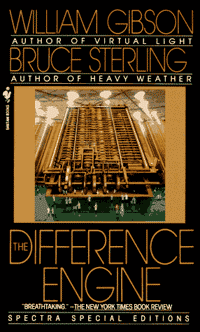The sky had become a bowl of smoke, roiling and thickening. The untoward sight seemed to panic the London starlings, for a great flock of the little birds had risen over the park. Mallory watched in admiration as he walked. Flocking activity was a very elegant lesson in dynamical physics. Quite extraordinary how the systematic interaction of so many little birds could form vast elegant shapes in the air: a trapezoid, then a lopped-off pyramid, becoming a flattened crescent, then bowing up in the center like the movement of a tidal surge. There was likely a good paper in the phenomenon.
This was of course the insight that gave birth to the contemporary field of Artificial Life and has influenced thinking in Artificial Intelligence. It is famously the inspiration of Craig Reynolds' simulation: boids.
The boids essentially follow three simple rules:
1) Move toward the perceived center of the flock.
2) Match speed with the closest boids.
3) Avoid collisions.
The simulated flocking behavior observed was so similar to actual observed flocking in real birds that it has since become a matter of general understanding that real birds flock under evolved instincts that approximate rules like these.
This discovery, in our world, occured in the early 1980s as the computer graphics field advanced to the point of being able to code such a visual simulation. In the world of The Difference Engine, we've already seen Kinotrope shows that are probably complex enough to do this. We've also seen that Mallory has used Engine analysis to simulate the stress-bearing properties of the Brontosaurus skeleton, saving him from the error of assumption that was made in our actual history, in which that animal was misconstructed as an amphibious pond-grazer. It seems like they are just a small step away from running a starling simulation, and discovering the basis of artificial life.
Half the fun of reading this book for me is seeing contemporary computer science backdated onto Victorian models. It really drives home how much of this knowledge is simply physically manifested mathematics, and that the physical medium (in our case silicon and electricity, in their case brass gears and steamcranks) is beside the point, mostly.
The tools were never the revolution, however much we've fetishized them.
(Also, and I know this observation is trite, but how amazing is online video? Instead of struggling to describe something as strange as a murmuration of starlings, I can just show it to you. If you've never seen it before, now you have. Visual sensation has been utterly* democratized.)
*This is Allana's favorite word.




No comments:
Post a Comment